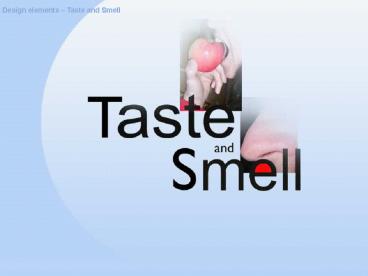Design Awareness in Schools - PowerPoint PPT Presentation
1 / 40
Title:
Design Awareness in Schools
Description:
Taste is a sensation we experience through the taste receptors on our tongue. ... apples, the slipperiness of baked custard, the creaminess of icecream, the ... – PowerPoint PPT presentation
Number of Views:52
Avg rating:3.0/5.0
Title: Design Awareness in Schools
1
Design elements Taste and Smell
2
Design elements Taste and Smell
About taste and smell
Taste is a sensation we experience through the
taste receptors on our tongue. Smell is a
sensation we experience through the olfactory
receptors in our noses. The experience of food
also involves sight sound touch.
3
Design elements Taste and Smell
Types of taste
The taste receptors in our mouth can detect four
basic sensations sweet salty sour bitter.
4
Design elements Taste and Smell
Types of smell
Smell is a complex interaction of many volatile
components. The olfactory receptors in our noses
can detect or discriminate between tens of
thousands of different smells.
5
Design elements Taste and Smell
Taste and smell can communicate
Taste and smell can suggest emotions
feelings ideas. Taste and smell can evoke
memories and psychological responses in
individuals.
6
Design elements Taste and Smell
Taste and smell can serve many design needs
Taste and smell can be used to represent
objects people places ideasin descriptive
or symbolic ways.
7
Design elements Taste and Smell
Smell can be pleasing, for example, perfume can
evoke a feeling of luxury, flowers can remind us
of spring.
8
Design elements Taste and Smell
Smells can be repellent, for example, a rubbish
bin or a toilet. Smells can suggest hospitals
and cleanliness.
9
Design elements Taste and Smell
Taste and smell can be functional
Pleasing tastes and smells can encourage us to
eat. Taste and smell can tell us when food is
unsafe to eat.
10
Design elements Taste and Smell
Other sensations associated with food
Astringency some types of food, such as unripe
bananas, can cause dryness and puckering inside
the cheeks. Hot/cool some types of food, such
as chilli or black pepper, can cause a sensation
of hotness. Other kinds of food, such as cucumber
or watermelon, can produce a sensation of
coolness. Pain/pungency some types of food,
such as mustard and horseradish/wasabi, can
produce a biting or burning sensation.
11
Design elements Taste and Smell
Texture, or the way food feels in the mouth, is a
sensation associated with eating, for example,
the crunch of raw celery, the crispness of fresh
apples, the slipperiness of baked custard, the
creaminess of icecream, the chewiness of minties
or the hardness of toffee.
12
Design elements Taste and Smell
Flavour is the total sensory impression formed
when food is eaten. Cultural background and
personal experiences can influence the way an
individual responds to food flavours.
13
Design elements Taste and Smell
The experience of food involves all of the
senses taste, smell, sight, sound and touch. The
cooking of all different cultures is recognisable
by distinct flavours.
China
India
Japan
Italy
Thailand
14
(No Transcript)
15
(No Transcript)
16
(No Transcript)
17
(No Transcript)
18
(No Transcript)
19
(No Transcript)
20
(No Transcript)
21
(No Transcript)
22
(No Transcript)
23
(No Transcript)
24
(No Transcript)
25
(No Transcript)
26
(No Transcript)
27
(No Transcript)
28
(No Transcript)
29
(No Transcript)
30
(No Transcript)
31
(No Transcript)
32
(No Transcript)
33
(No Transcript)
34
(No Transcript)
35
(No Transcript)
36
(No Transcript)
37
(No Transcript)
38
(No Transcript)
39
(No Transcript)
40
(No Transcript)































